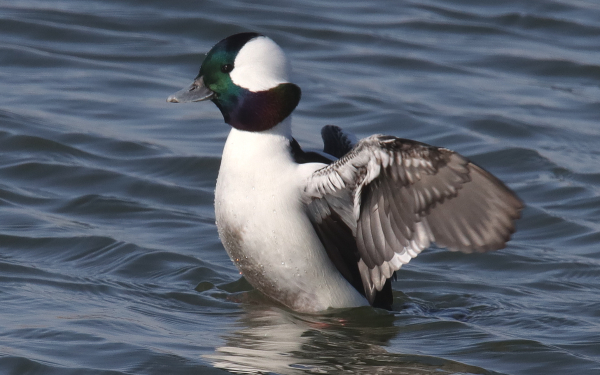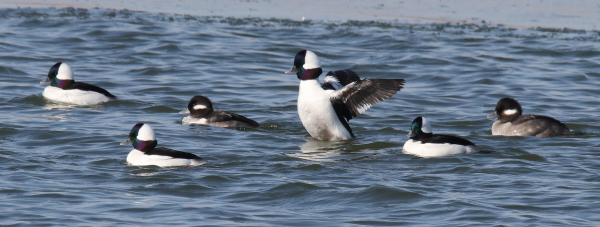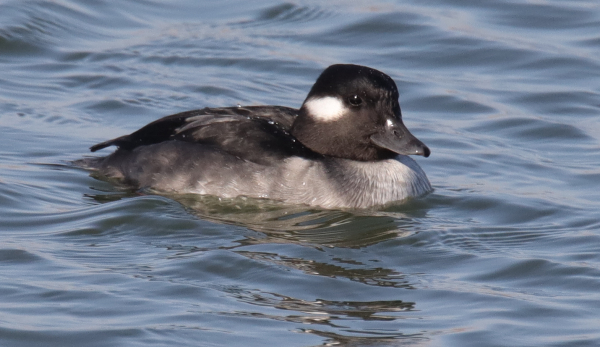Thursday November 2nd was an epic day to explore the birds of late migration. Most impressive was a wealth of birds in small area distinguished by 2 large lakes, 1 on each end of a 3-mile stretch of road. The partly frozen lake on the north side of this area caught my attention – not the lake so much as the concentration of ducks in the open water areas near the road. Large mixed-species flocks of ducks were feeding along the edge of the ice that covered the surface of most of the lake, including many Buffleheads and Lesser Scaup numbering more than 100, with a few Canvasbacks and Hooded Mergansers mixed in along with a lone male Common Goldeneye.

A close portrait of a relaxed male Bufflehead shows how a little sunshine makes a big difference in lighting up the iridescent plumage of the small duck’s face. You can also see the sun mirrored in the Bufflehead’s eye (photo info: 600mm zoom lens, f-8 aperture, 1/1600 shutter speed, ISO 400).
|
The late season ducks provided some interesting photo ops from a distance, along with a chance to photograph a foraging Canvasback at close range that was diving for extended periods, surfacing with a lot of mud on its long bill – evidence of its digging in the muddy clay substrate for plant roots or small crustaceans. (I shared a photo I took of the Canvasback with mud on its beak in last week’s Editor Afield article.)
The freezing-cold water was ice-covered along the northeast side of the lake, but I could see that a small opening in the ice was occupied by a trio of male Buffleheads. Even though I know how wary Buffleheads almost always are, I somehow thought this threesome might permit a photo approach as I carefully, slowly eased into position using my mobile blind (my car). Before I was within zoom lens range, 2 of the male Buffleheads took flight – no big surprise; but one remained, to my delight.
With the iridescent feathers on its face shining blue, green, and violet in the late morning sun, I took a couple documentary photos as the Bufflehead hesitated in the icy blue water a few tense moments marked by the beating of my heart. Would it dive again, or take flight? It was a moment of concern, until the little duck raised up and dived head-first under the surface of the water. I took a deep breath as I waited for the Bufflehead to re-appear. Then pop, there it was, as though it literally popped out of the sky blue water. I photographed the Bufflehead again, waiting for it to turn into the sun to emphasize the colors of its facial feathers, which appear black when not illuminated. Indeed, Buffleheads provide a true test of lighting – without sunlight they look black and white; with sunlight their iridescent facial plumage is striking.

The diving, waiting, surfacing, and photographing process repeated many times during the next 15 minutes, which turned into a bit of a “where’s the duck going to pop up” game while waiting for it to surface. But because the opening in the ice was only about 40 feet long, the Bufflehead was usually within good photo range. Suddenly a female Bufflehead flew into view, made a pass on the wing, then landed to feed in the opening in the ice too, providing a second photo subject. The male and female didn’t interact beyond acknowledging one another, but although she was a little warier and more of a standoff, the female eventually provided another Bufflehead look when I was able to take a few portrait-quality photos in between dives.
Aside from diving and short swims between dives, the Buffleheads didn’t provide much action to photograph. Yes, I photographed the movements of the little jump they made to begin their diving action before disappearing into the water, but I had to be patient to witness much more. With time, the male Bufflehead transitioned into tending to some maintenance activities, including preening – and then it happened, the attractive little duck reared up and flapped its wings, providing me with a signature photo of the species – hooray!

The light couldn’t have been better, and while I started this photo session using an ISO of 800, about halfway through the shared period I changed the ISO back to my usual 400. I made this change because I was worried the bright sunlight that was leaning toward midday intensity seemed to be overpowering the white plumage of the male. However, when I reviewed the photos on my laptop that evening, it turned out my concern was unfounded, and I returned to using an ISO 800 thereafter.
The reason I changed to ISO 800 during the past 2 weeks is to get faster shutter speeds, which are better for flight photos and other action photographs. Also, the ISO 800 allows me to make a broader area in focus by using an aperture of f-10 to f-14 to accommodate flocks of ducks, geese, and swans, as well as pairs, or more of the surrounding area in focus – even if it’s just the ripples on the water. As the Buffleheads popped onto the water’s surface, my Tamron 150-to-600 zoom lens went into play as I zoomed in and out, depending on how close one of the ducks surfaced to my car.

As noted last week, the sun’s position in the sky is much farther south now, as it will be for months to come, especially at this northern latitude. Now it’s possible to photograph throughout the day from mid-morning to late afternoon with little concern for the effect of an overhead sun that we must contend with during midday throughout the summer months. Considering I was photographing the Buffleheads between 10:15 and 11:30, the resulting photos are testimony to being able to photograph during midday as well as morning and afternoon – that’s a big plus for all of us.
During this Bufflehead photo session I repositioned a few times; not far, just 12 feet at the most, but it meant starting the engine and motoring forward or backward a bit, which I tried to do when the ducks were submerged. Even so, the Buffleheads were aware of the adjustments, but took them in stride. I appreciated that these were not normal Buffleheads, known for their wariness and preference for staying in larger lakes, far away from shorelines. And that was the key to my success in photographing these charismatic little ducks – they were trusting, and I did nothing to make them question that trust.

These Buffleheads were ambassadors – birds I seek out that I consider to be a prime example of their species – that allow a fairly close approach within photo range and permit extended photo opportunities. During such a photo session, you begin to feel you know the individuals, and the species better, having shared that time together. I have found that spending time with an avian ambassador is one of the most fulfilling things about birding, and it’s the best way to get intimate photos of the birds behaving naturally. I hope you come to know this kind of kinship with some birds you encounter – and that you reap the photographic rewards of sharing some time together. Good Luck!
Article and photographs by Paul Konrad
Share your bird photos and birding experiences at editorstbw2@gmail.com